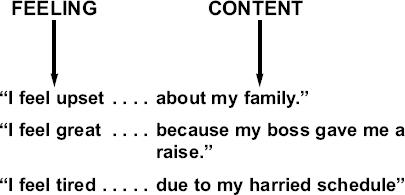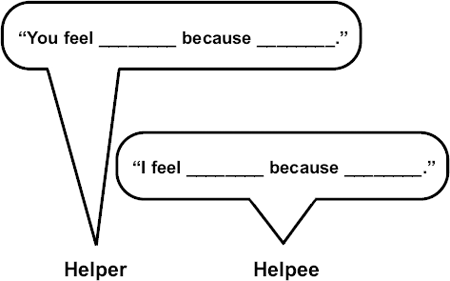Responding to the feeling or the content of the helpees’ expressions is not enough. Our response must be enriched by combining the feeling together with the content for the helpees.
Content is used to make the feeling meaningful. The content gives intellectual meaning to the helpees’ expressions of their experiences. The feeling gives emotional meaning to the helpees’ expressions of their experiences. Responding to meaning emphasizes making interchangeable responses that capture both the feeling and content of the expressions.

RESPONDING TO MEANING
Perhaps no other single construct is as fundamental to our understanding of daily life as the principle of cause and effect. Nothing occurs in a vacuum. There is a reason for every event that takes place. And every feeling, however elusive and insubstantial it may seem, is prompted by some specific cause or causes.
Many of our feelings seem quite rational in the sense that most other people would feel the same way if the same things happened to them. But we also have feelings that seem to make little or no sense to others. Whatever we see as the cause of our feelings may not appear sufficient when viewed by other people. In still other cases, we may not realize the cause for our feelings.
Helpers must remember this: Regardless of the apparent nature of the cause of a particular helpee’s feelings, each of those feelings will always turn out to have a sufficient reason for the helpee! One of the most important goals of helpee exploration is to identify—for the helper as well as for the helpee—the helpee’s reason for each real feeling.
MEANING RELATES CAUSE AND EFFECT
Remember, feelings are about content. The content provides the reason for the feeling. For example, let us look at several feeling states and related content areas.
| Feeling | Content |
| Happy | about being promoted |
| Angry | with my teacher for giving me a low grade |
| Sad | when I knew that I’d never see her again |
We may practice responding to meaning by determining the feeling and content of different experiences in our own lives.

FEELINGS ARE ABOUT CONTENT
A response to meaning is not complete until it communicates both feeling and content. A response to meaning can be communicated by complementing a response to feeling with a response to content. For example, whereas “You’re saying that ________” expressed the content of the helpee’s expression and “You feel that ________” expressed the helpee’s feelings, “You feel ________ because ________” captures both the feeling and the content. This is an effective format for a complete interchangeable response to the helpee.

RESPONDING INTERCHANGEABLY
It is as if we try to understand with our minds what the helpees feel in their guts. We do this by crawling inside of their feelings. Then, we comprehend the reason for the feelings expressed in their content.
Whereas “You feel sad” expresses the helpee’s feelings with the passing of a loved one, “You feel sad because she was the most important person in the world to you and now she is gone” captures the meaning of the feeling and the content.

CAPTURING BOTH THE FEELING AND THE CONTENT
You may feel frustrated because you have been learning to make all responses to meaning in a single format: “You feel ________ because ________.” Actually, there are many other ways to communicate a response to meaning. What is critical is that a response to meaning communicates how the helpee feels and the content, or reason, for the feeling. For training purposes, it is recommended that you continue to practice using the “You feel ________ because ________” format. Later, you will formulate and communicate responses to meaning (feeling and content) in your own way.
Here are a few examples of alternative ways to formulate an interchangeable response to meaning:
“You feel (feeling) because (content).”
“You feel sad because he moved away.”
“You’re (feeling) about (content).”
“You’re sad about his leaving.”
“ (Content) you feel (feeling).”
“Your close friend moved away and now you feel sad.”
“Because (content) it’s got you feeling (feeling).”
“Because he moved away it’s got you feeling sad.”
“It’s (feeling) when (content).”
“It’s a sad time when a close friend moves away.”
RESPONDING TO MEANING CAN TAKE MANY FORMS
The helpees inform us of their readiness to move from exploring where they are in relation to their experiences to understanding where they want or need to be. They alert us by demonstrating their ability to communicate how they feel and the reasons for these feelings. In other words, the helpees inform us of their readiness by doing for themselves the things that we have been doing for them.

HELPEES SIGNAL THEIR READINESS TO MOVE FROM EXPLORATION TO UNDERSTANDING
